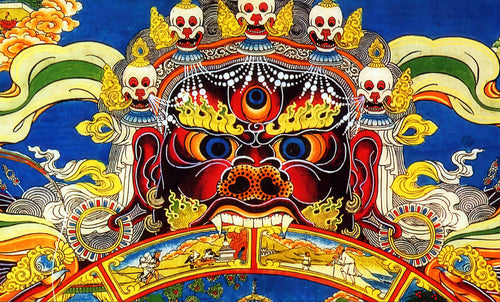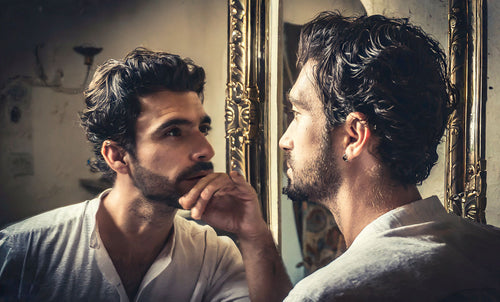Sports and Meditation. The State of Flow
Alessandro RusticelliIt is well known that the practice of meditation produces a stable change in the perception of reality. As our awareness expands, in fact, we become capable of grasping more subtle aspects of experience and gradually the sense of separation between us and the rest of the world loosens. In meditation, when we are attuned to the silent background of consciousness, we continue to maintain - albeit in a mild form - a dualistic perception of reality. In other words, there is still a distinction between self and non-self. However, it can happen that at some moments this residue of ordinary consciousness suddenly disappears, allowing us to grasp the true nature of things, the emptiness that the Buddhist philosopher Nagarjuna spoke of (in the image below).

In the modern world, however, not many have the time and patience to dedicate to meditation and, in their free moments, many prefer to relax by doing sports. But is it possible to reconcile the two needs? Can a physical activity become a form of meditation? Well, yes, if we know how.
Meditation is generally thought of as a static practice, which is done sitting on a cushion, in the silence of a retreat or in one's own home. In reality, in the Buddhist tradition, but also in other Eastern religions such as Hinduism or Taoism, there are dynamic forms of meditation. In Theravada monasteries, for example, they practice mindful walking, a type of meditation in movement, which monks alternate with the traditional technique to "stretch their bones" and improve circulation. In Taoism, this function is performed by Tai-Qi, a set of movements that in the past were used for fighting and, once obsolete, were collected in choreographies (forms) that people can use to keep fit and develop awareness. In performing the slow and harmonious gestures of Tai-Qi, the mind focuses on the present moment, leaving aside all other occupations. In this way, the individual is able to enter a mental state of profound calm, feeling in harmony with what surrounds him.

The first to observe phenomena of this type in controlled and repeatable conditions was, in the 70s, Mihaly Csikszentmihalyi . The psychologist, of Hungarian origins, described the state of flow , a new phenomenon for Western science, which has always given little importance to the study of "altered" states of consciousness, especially those that are not linked to pathological phenomena. Flow is a temporary mental condition in which the individual is completely immersed in the present. This state is often described as a pleasant experience, in which one has the sensation of being one with the surrounding reality and of having full control over oneself. The ancient Zen masters had noticed this phenomenon and called it Mu-shin , or no-mind, to underline the absence of thought and the deep harmony with the environment. Today many sports coaches try to trigger this state in their pupils, aware of the fact that in flow concentration improves together with the ability to respond to external stimuli, increasing the chances of victory.

The interesting aspect of flow is that it has a lot in common with the experiences that are lived during meditation, while remaining a circumscribed phenomenon and linked to specific activities. Both states, in fact, imply a deep concentration and a notable reduction of the "mental noise", that is, the continuous internal chatter that characterizes our minds. When a person enters the flow, he is totally immersed in the activity he is carrying out and forgets about everything else, including the passage of time. In fact, a temporary suspension of the sense of self is triggered, exactly as happens in meditation, where attention is intentionally diverted from the content of thoughts, which are observed objectively and without getting involved. It is precisely for this reason that the experience of flow is associated with a deep sense of satisfaction: it, like meditation, frees us from ourselves, to make room for the reality of the present moment. How to enter the state of flow during a sporting activity? Here are some small tips based on my personal experience:
- It is important to choose engaging physical activities , preferably simple and characterized by the presence of repetitive, but not mechanical, gestures. Think for example of tennis, fit-boxing or the execution of a kata in karate.
- you have to minimize distractions or minimize sources of external disturbance, focusing exclusively on what you are doing. In this case the environmental factor becomes decisive and you can use some tricks, such as music, to make the context less disturbing.
- the flow state is favored by activities that provide immediate feedback , without leaving time to think about anything else. For example, in tennis, during the exchange we do not have time to stop and think between one shot and the next and if we do, we will probably lose the point. This kind of rhythmic activity that requires continuous attention is ideal for triggering the flow state.
- It is possible to facilitate entry into the flow with small measures that improve concentration , create the right mood to immerse oneself in the experience or reduce environmental disturbance. One of these is music, as competitive athletes know well, who before a race often wear headphones while trying to enter the right mental state. However, if music is not well chosen or adds noise to an already chaotic environment, it can easily turn into a source of disturbance.
Of course, there are important differences between flow and meditation and it is necessary to be aware of them. The first, in fact, is a condition linked to a specific activity that lasts for a limited time (from a few minutes to an hour), while meditation is a technique created specifically to prolong and stabilize the changes in consciousness that we have just described. The purpose of meditative techniques is first of all spiritual, unlike flow which can be used in many different contexts. Vipassana, transcendental meditation and other techniques serve to free the individual from attachment to the Ego, through a deep understanding of the ultimate nature of reality.

Even though the goals are very different,
the psychological and neurological basis that allows these experiences is the same.
This allows us to say that flow is a sort of "little meditation" that we can all experience from time to time, without giving up the pleasure of movement and physical activity. It is the basis of initiatives now widespread throughout the world such as "mindful cycling", a way of practicing cycling that is enjoying ever-increasing success and can be an example for other sports.
















































